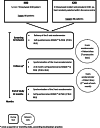Comparison of physical activity and quality of life in home haemodialysis (HHD) patients versus conventional in-centre haemodialysis (ICHD) patients: the observational, longitudinal, prospective, international, multicentric SeCoIA study protocol
- PMID: 33225917
- PMCID: PMC7682091
- DOI: 10.1186/s12882-020-02127-7
Comparison of physical activity and quality of life in home haemodialysis (HHD) patients versus conventional in-centre haemodialysis (ICHD) patients: the observational, longitudinal, prospective, international, multicentric SeCoIA study protocol
Abstract
Background: Home haemodialysis (HHD), has shown improved clinical outcomes, as well as a better quality of life, compared to conventional in-centre haemodialysis (ICHD) but still has a global low prevalence among end-stage renal disease patients. Haemodialysis (HD) patients tend to be sedentary but only few studies, mainly in North American ICHD patients, have evaluated the level of activity in HD patients.
Methods: SeCoIA is an observational, longitudinal, prospective, international, multicentric, study, conducted in metropolitan France and Belgium. The main objective of the study is to quantify the physical activity measured by the total daily number of steps, in HHD patients compared to ICHD patients. The SeCoIA study will include 80 HHD patients and 80 ICHD patients,. Secondary objectives will be to characterize the HHD population and to confirm HHD efficiency on clinical parameters, as well as quality of life (QoL), in current practice. Physical activity will be measured by a 3-axis accelerometer. Accelerometers have been shown to provide accurate information, on both physical activity and sedentary behaviour. Patients will be instructed to wear the device and complete a patient diary 7 consecutive days after inclusion and the first week of each month for 12 months. Decision to undergo HDD or ICHD is independent of the study and follow-up frequency remains at the discretion of the physician/centre. QoL and quality of sleep will be respectively assessed by the Kidney Disease Quality of Life 1.2 (KDQOL™) and the Pittsburg Sleep Quality index (PSQI) questionnaires at inclusion, 6- and 12-month visits. Patients presenting a restless leg syndrome (RLS) will also complete the International Restless Legs Syndrome rating scale (IRLS) questionnaire.
Discussion: The SeCoIA study will be the first large cohort study (160 patients) evaluating physical activity, objectively measured with a 3-axis accelerometer, in HHD versus ICHD patients. The present study will also include a comparison of QoL with a focus on RLS between HHD and ICHD. It is anticipated that HHD patients will have an improved physical activity and QoL which should encourage physicians to further promote HHD.
Trial registration: Clinical trial NCT03737578 study registered on November 9, 2018 (Retrospectively registered).
Keywords: 3-axis accelerometer; End-stage renal disease; Home haemodialysis; Physical activity; Quality of life; Restless leg syndrome.
Conflict of interest statement
NT, CC and PAM have no conflict of interest. SD is an employee of Monitoring Force, a contract research organisation working for different pharmaceutical companies. MT is an employee of Physidia SAS.
References
-
- Wang H, Naghavi M, Allen C, Barber RM, Bhutta ZA, Carter A, et al. Global, regional, and national life expectancy, all-cause mortality, and cause-specific mortality for 249 causes of death, 1980–2015: a systematic analysis for the global burden of disease study 2015. Lancet. 2016;388:1459–1544. doi: 10.1016/S0140-6736(16)31012-1. - DOI - PMC - PubMed
-
- rapportrein2016.pdf. https://www.agence-biomedecine.fr/IMG/pdf/rapportrein2016.pdf. Accessed 22 Jan 2019.


